In this article, I will delve into the linguistic subtleties of “fruit vs fruits” and provide my insights on the correct usage for daily conversations and writing. We will explore the difference between fruit and fruits, discuss the singular and plural forms of fruit, define what constitutes a fruit, and provide examples to clarify any confusion.
Have you ever wondered what the difference is between “fruit” and “fruits”? Do you ever find yourself unsure whether to use the singular or plural form in your writing? Well, you’re not alone! The usage of these terms can be quite confusing, but fear not, I’m here to shed some light on the matter.
Key Takeaways:
- The main difference between “fruit” and “fruits” lies in their usage and grammatical context.
- “Fruit” is the singular form, referring to a single piece or type of fruit.
- “Fruits” is the plural form, used when referring to multiple pieces or types of fruit.
- Understanding the botanical definition of fruit helps clarify its usage and distinguish it from other plant parts.
- Choosing organic fruits offers numerous benefits for our health and the environment.
Understanding the Difference Between Fruit and Fruits
The main difference between fruit and fruits lies in their usage and grammatical context. When we refer to fruit, we are talking about a single piece or type of fruit. On the other hand, fruits is used when we are talking about multiple pieces or types of fruit. This distinction is crucial for maintaining grammatical accuracy in both writing and conversations.
Let’s dive deeper into the difference between fruit and fruits to better understand their usage. When we use the singular form, fruit, we are referring to one specific fruit. For example:
I am enjoying a delicious fruit salad.
In this sentence, we are emphasizing the consumption of a single type of fruit, without specifying the exact fruit present in the salad.
On the other hand, when we use the plural form, fruits, we are talking about more than one piece or type of fruit. For example:
I have a variety of fruits in my kitchen.
In this sentence, we are highlighting the presence of multiple types of fruit, indicating that there is a diverse range of fruits in the kitchen.
To summarize, fruit is the singular form, used for one specific piece or type of fruit, while fruits is the plural form, used for multiple pieces or types of fruit. Understanding the difference between these two forms is crucial for maintaining grammatical accuracy and clear communication.
Examples:
- I bought a fruit at the store.
- I bought several fruits at the store.
- She enjoys eating fruit.
- She enjoys eating fruits.
These examples showcase how the singular and plural forms of fruit can be used in different contexts to convey specific meanings.
Exploring the Singular Form of Fruit
The singular form of fruit refers to a single piece or type of fruit. It is used to denote a specific fruit without any reference to quantity or plurality. For example, if you say “I am eating a fruit,” you are referring to a single piece of fruit without specifying the type. The singular form of fruit allows for more precise language when discussing individual fruits.
Using the singular form of fruit is particularly useful when you want to focus on the characteristics of a specific fruit. By using a fruit, you can convey that you are referring to any type of fruit without specifying a particular kind.
Here’s an example:
“I am enjoying a fruit with breakfast.”
In this sentence, the singular form of fruit is used to indicate that the speaker is enjoying a single piece of fruit, without mentioning the specific variety. It leaves room for imagination and keeps the description broad.
To provide a comprehensive overview of the difference between the singular and plural forms of fruit, here is a comparison table:
| Singular Form | Plural Form |
|---|---|
| Refers to a single piece or type of fruit | Refers to multiple pieces or types of fruit |
| Used when discussing individual fruits | Used when discussing multiple fruits |
| Emphasizes specificity | Allows for inclusivity |
This table highlights the key differences between the singular and plural forms of fruit. While the singular form focuses on individual fruits, the plural form encompasses a broader range of fruits.
Understanding the Plural Form of Fruit
The plural form of fruit, or fruits, is used to denote multiple pieces or types of fruit. It is used when there is more than one fruit being discussed. For example, if you say “I like to eat fruits,” you are referring to a variety of different fruits. The plural form allows for a broader and inclusive discussion of multiple fruits.
In the context of language and grammar, understanding the difference between the singular form of fruit and its plural counterpart, fruits, is essential for effective communication. While the singular form refers to a single fruit, the plural form encompasses a range of fruits, emphasizing diversity and variety.
“I like to eat various fruits every day. Apples, bananas, and oranges are some of my favorites.”
By using the plural form, we acknowledge the presence of numerous fruit options rather than limiting ourselves to just one. This inclusivity allows for a more comprehensive exploration of the various types and flavors of fruits available.
It’s important to note that the plural form of fruit is often used in general statements or when discussing fruit as a food group. Additionally, when referring to multiple types of the same fruit, such as different varieties of apples or oranges, the plural form is preferred.
Examples of Using the Plural Form of Fruit:
- I enjoy eating fruits.
- We have a basket full of fruits.
- She juices a variety of fruits.
The plural form of fruit adds flexibility and inclusivity to our language, allowing us to express our love for the wide array of fruits that nature has to offer. It enables us to discuss multiple fruit types in a single statement, highlighting the abundance and diversity of nature’s sweet and juicy creations.
Defining What Constitutes a Fruit
To understand the difference between fruit and fruits, it is important to define what constitutes a fruit. In botanical terms, a fruit is the mature ovary of a flowering plant, typically containing seeds. It develops from the fertilized flower and serves as a means of seed dispersal. Fruits can be fleshy or dry, and they come in a wide variety of shapes, sizes, and flavors. Understanding the botanical definition of fruit helps clarify its usage and distinguish it from other plant parts.
The Botanical Definition of Fruit
In botany, a fruit is described as the mature ovary of a flowering plant. After fertilization, the ovary undergoes changes and transforms into a fruit, which contains the seeds of the plant. This process is essential for the plant’s reproductive cycle and the dispersal of its seeds.
There are two main categories of fruits:
- Fleshy Fruits: These fruits have a fleshy or juicy texture. Examples include apples, oranges, and strawberries.
- Dry Fruits: These fruits have a dry texture and include nuts, grains, and beans.
The variety of fruits is vast, ranging from small berries to large melons, and from elongated bananas to spherical oranges. Each fruit has its own unique shape, size, and color, making them easily distinguishable.
The Purpose of Fruits
Fruits play a crucial role in the life cycle of plants. They serve as a protective covering for seeds, ensuring their safe dispersal. Animals, insects, or natural elements help in spreading seeds through consumption or physical movement.
The flavors, colors, and aromas of fruits are adaptations that attract animals, ensuring they consume the fruit and disperse its seeds elsewhere. This mutualistic relationship between plants and animals is essential for the survival and propagation of many species.
| Fruit Type | Definition | Examples |
|---|---|---|
| Fleshy Fruits | Fruits with a juicy texture | Apples, oranges, strawberries, grapes |
| Dry Fruits | Fruits with a dry texture | Nuts, grains, beans, capsules |
The Versatility of Fruits
Fruits are not only varied in their shapes and sizes but also in their flavors and nutritional profiles. They are abundant sources of vitamins, minerals, fiber, and antioxidants, making them essential in maintaining a healthy diet.
From the tartness of lemons to the sweetness of mangoes, fruits offer a diverse range of flavors that can satisfy a wide range of taste preferences. Their versatility extends to their uses in culinary endeavors, where they can be enjoyed fresh, juiced, pureed, baked, or incorporated into savory dishes and desserts.
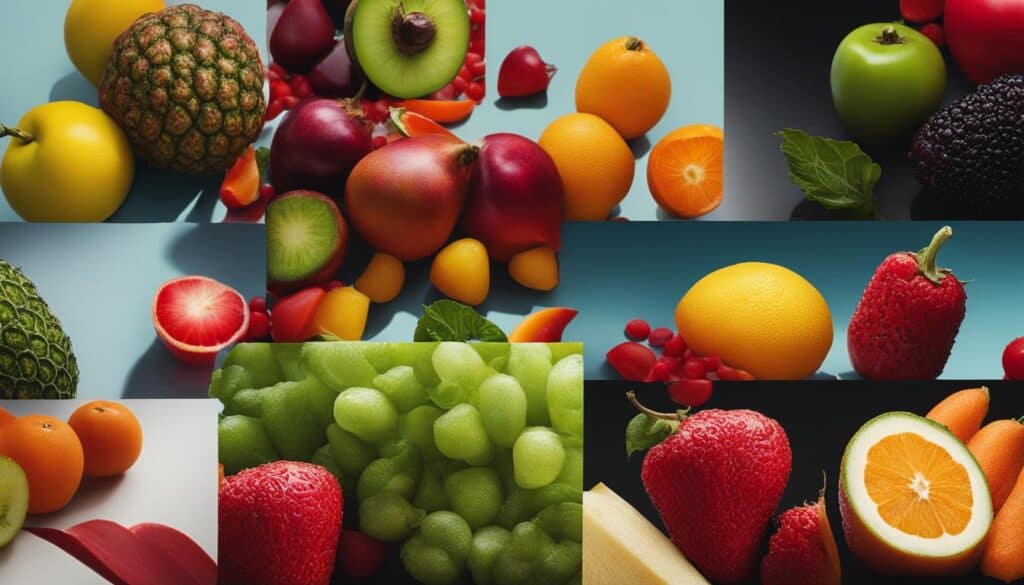
Examining Examples of Fruit vs Fruits Usage
Let’s examine some examples to clarify the usage of fruit vs fruits. The distinction between the singular and plural forms of these words is crucial for precise communication. Below are a few scenarios that illustrate their proper usage:
- “I bought a fruit at the store.” This sentence refers to the purchase of a single piece of fruit, without specifying the type. The singular form “fruit” is used here to denote one fruit in general.
- “I bought several fruits at the store.” In contrast to the previous example, this sentence indicates the purchase of multiple types of fruit. By using the plural form “fruits,” we emphasize the diversity of fruit types bought.
- “She enjoys eating fruit.” This statement suggests a general preference for all fruits. The singular form “fruit” conveys a broad appreciation for the overall category of fruits.
- “She enjoys eating fruits.” In this case, the plural form “fruits” implies a preference for various specific fruits. It depicts a particular fondness for different types of fruits, rather than the entire category as a whole.
These examples highlight how the choice between “fruit” and “fruits” depends on the specific context and intended meaning. Properly discerning and using the correct form ensures effective communication and avoids confusion.
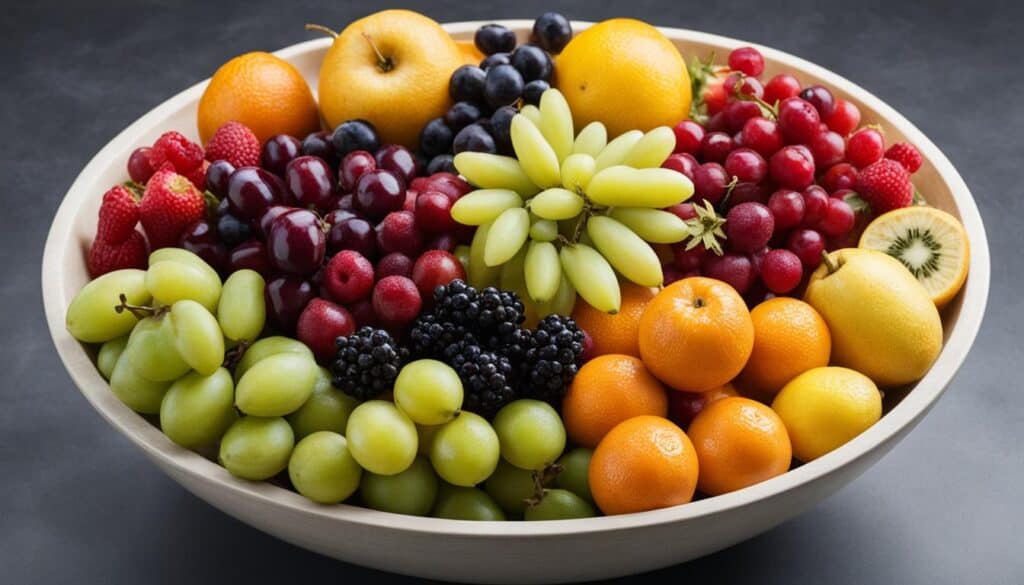
Examining these usage examples clarifies the difference between “fruit” and “fruits” and provides a better understanding of how these terms are employed in different contexts.
The Benefits of Organic Fruits
Organic fruits offer numerous benefits, both for our bodies and the environment. When it comes to organic farming, the emphasis is on growing fruits without the use of synthetic fertilizers, pesticides, and genetically modified organisms (GMOs). This natural approach to cultivation has far-reaching positive impacts on biodiversity, pollution reduction, and soil quality enhancement.
By adopting organic farming practices, farmers are able to preserve and promote biodiversity in their fields. This means preserving different varieties of fruits and the ecosystems that support them. Additionally, organic farming methods help reduce pollution by minimizing the release of harmful chemicals into the air, soil, and waterways. Reduced pollution translates to a healthier environment for both humans and wildlife.
One of the key advantages of organic fruits is that they are grown without the use of synthetic pesticides. This makes them a safer and healthier choice for consumers. By consuming organic fruits, we can avoid potential exposure to harmful chemical residues found in conventionally grown fruits.
Furthermore, organic fruits tend to be more nutrient-dense and flavorful. This is because organic farming practices focus on building and maintaining nutrient-rich soil. By avoiding the use of synthetic fertilizers, organic farmers rely on natural fertilizers such as compost and manure. These natural fertilizers enrich the soil, providing essential nutrients to the plants and resulting in fruits that are packed with vitamins, minerals, and antioxidants.
Choosing organic fruits also supports sustainable farming practices. By opting for organic options, consumers are encouraging farmers to continue employing environmentally friendly techniques that promote the long-term health of the land. Through sustainable farming, we can contribute to the overall well-being of our planet and foster a healthier ecosystem for future generations.
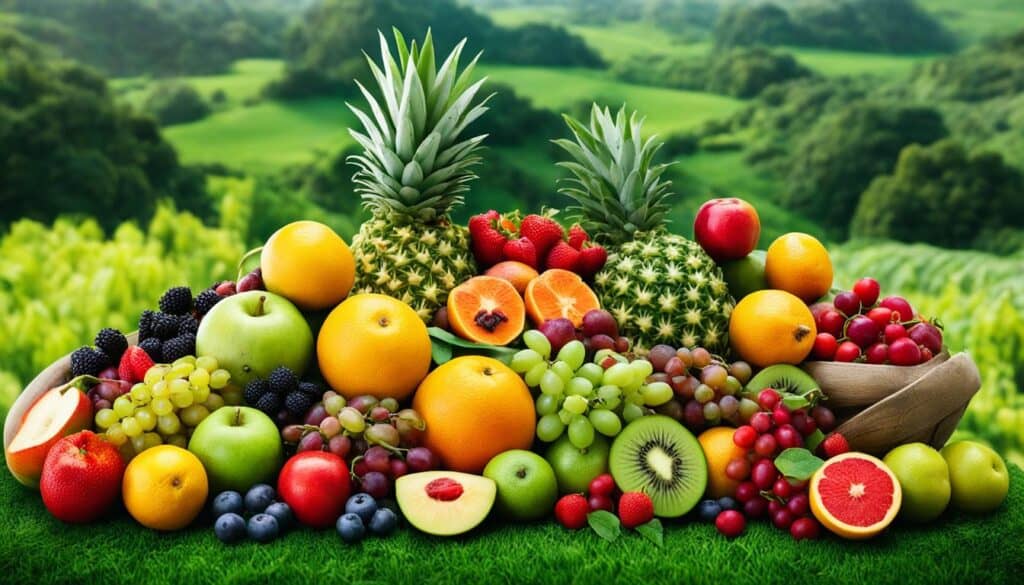
Key Benefits of Organic Fruits:
- Promotes biodiversity
- Reduces pollution
- Enhances soil quality
- Safe and healthy to consume
- More nutrient-dense and flavorful
- Supports sustainable farming practices
Tips for Choosing the Best Organic Fruits
When it comes to selecting organic fruits, there are a few important factors to consider. By keeping these tips in mind, you’ll be able to choose the best organic fruits that are not only delicious but also good for your health and the environment.
- Go for in-season fruits: Opt for fruits that are in season as they tend to be fresher, tastier, and more affordable. In-season fruits are also more likely to be sourced locally, reducing the carbon footprint associated with long-distance transportation. Plus, supporting local farmers strengthens the local economy.
- Pay attention to color and texture: When selecting organic fruits, the color and texture can provide clues about their quality and ripeness. Look for vibrant colors that are specific to the fruit variety. For example, deep red strawberries or bright orange mangoes are indicators of ripeness and flavor. Additionally, gently squeeze the fruit to check for firmness, as overly soft fruits may be overripe or damaged.
- Buy from local farmers: Purchasing organic fruits directly from local farmers is an excellent way to support sustainable agriculture and get the freshest produce. Local farmers often prioritize environmentally friendly farming practices and may have a smaller carbon footprint compared to large-scale industrial farming operations.
By following these tips, you can confidently choose the best organic fruits that are both environmentally friendly and bursting with flavor. Enjoy the natural goodness and numerous benefits that organic fruits bring to your table!
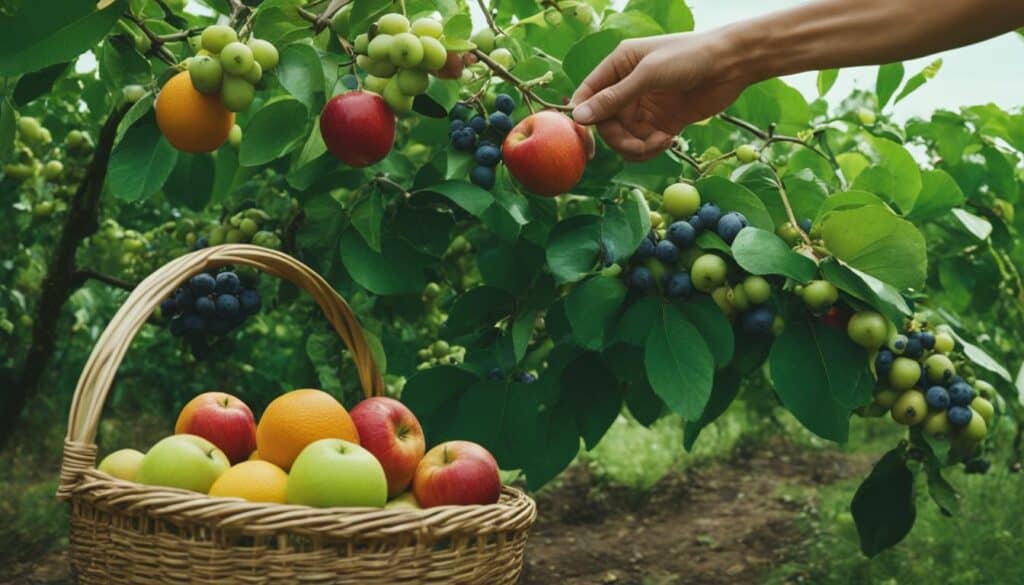
Choosing organic fruits is a healthy choice for both your well-being and the environment.
Exploring the Science Behind Fruit Flavors
The flavors we experience in fruits are a result of the interaction between our taste receptors and the compounds found in fruits. Fruit flavors are a complex combination of sugars, acids, and aromatic compounds that interact with our taste buds and olfactory system.
These compounds create the unique sensations of taste, including sweet, sour, salty, bitter, and umami. The presence and concentration of these compounds contribute to the specific flavor characteristics of different fruits.
Taste perception is not solely determined by our taste buds. Our sense of smell, texture, and even temperature also play important roles in how we perceive fruit flavors. The combination of these sensory factors creates a multi-dimensional experience when enjoying fruits.
“The flavors we experience in fruits are the result of a beautiful symphony of compounds that interact with our senses to create a delightful taste experience. It’s a truly captivating exploration of sweetness, tanginess, and so much more.”
For example, the sugars in fruits, such as fructose, contribute to their sweet flavor. Acids, such as citric acid in citrus fruits, give fruits their refreshing tartness. Salty flavors can be present in certain tropical fruits, while bitter flavors can be found in citrus peels or certain berries. Umami, often described as a savory taste, can be detected in ripe tomatoes or certain tropical fruits like durian.
Understanding the science behind fruit flavors allows us to appreciate the complexity and diversity of fruits. It adds a deeper layer of enjoyment to our culinary experiences, as we savor the intricate balance of taste sensations that fruits provide.

Exploring the Spectrum of Fruit Tastes
The world of fruits offers a wide spectrum of tastes to explore. From sweet and luscious to sour and tangy, each fruit has its own unique flavor profile.
- Sweet fruits: Strawberries, mangoes, and watermelons are just a few examples of fruits that offer delightful sweetness. The intensity of sweetness can vary, creating a range of flavor experiences.
- Sour fruits: Lemons, grapefruits, and certain berries provide a zesty burst of acidity. These fruits add a refreshing and tangy twist to our taste buds.
- Tangy fruits: Some fruits, like pineapples and kiwis, offer a unique combination of sweetness and tartness, resulting in a tangy flavor that is both energizing and satisfying.
- Bitter fruits: Grapefruits and pomegranates are known for their bitter notes. These fruits add a distinctive complexity to our taste experience, balancing other flavors in a unique way.
Embracing the diversity of fruit tastes allows us to embark on a culinary adventure like no other. Exploring new flavors, combinations, and textures opens up a world of possibilities to tantalize our taste buds and expand our gastronomic horizon.
Exploring the Spectrum of Fruit Tastes
The world of fruits offers a wide spectrum of tastes to explore. From sweet and luscious to sour and tangy, each fruit has its own unique flavor profile.
Sweet fruits: Strawberries and mangoes are perfect examples of sweet fruits. They offer delightful sweetness that can range in intensity, satisfying even the most discerning palates.
Sour fruits: Lemons and grapefruits are known for their zesty burst of acidity. These fruits awaken the taste buds with their tangy flavors, adding a refreshing twist to any culinary creation.
Tangy fruits: Citrus fruits like oranges and tangerines fall into the tangy category. They strike a balance between sweetness and acidity, creating a tantalizing flavor that leaves you craving for more.
Bitter fruits: Grapefruits and pomegranates offer a complex and intriguing flavor dimension with their bitterness. These fruits add a unique taste profile to dishes and provide a culinary adventure for those seeking a more adventurous flavor experience.
Embracing the diversity of fruit tastes allows for a culinary adventure like no other. Whether you have a sweet tooth, enjoy tangy flavors, or appreciate the complexity of bitter fruits, there is a fruit out there waiting to tantalize your taste buds.
| Fruit Type | Taste Profile |
|---|---|
| Sweet Fruits | Strawberries, mangoes |
| Sour Fruits | Lemons, grapefruits |
| Tangy Fruits | Oranges, tangerines |
| Bitter Fruits | Grapefruits, pomegranates |
Conclusion
In conclusion, understanding the difference between fruit and fruits, as well as their singular and plural forms, is essential for maintaining grammatical accuracy and clear communication. When it comes to organic produce, opting for organic fruits brings numerous benefits for both our health and the environment.
Choosing the best organic fruits involves considering factors such as seasonality, color, texture, and supporting local farmers. By selecting fruits that are in season, vibrant in color, and firm in texture, we can ensure freshness and optimal taste. Additionally, buying from local farmers not only supports the local economy but also reduces the carbon footprint of our food.
The science behind fruit flavors reveals the fascinating complexity of taste perception. The combination of sugars, acids, and aromatic compounds in fruits creates a plethora of sweet, sour, salty, bitter, and umami flavors. Our sense of taste, smell, texture, and temperature all contribute to the overall fruit flavor experience, making each bite a delightful sensory adventure.
So, the next time you encounter the debate of “fruit vs fruits,” remember the linguistic nuances and embrace the richness and diversity of flavors that both singular and plural fruits bring to our lives. Whether you’re enjoying a single ripe apple or a medley of succulent berries, the world of fruits offers a bountiful feast for our senses.
FAQ
What is the difference between fruit and fruits?
The main difference lies in their usage and grammatical context. “Fruit” is the singular form, referring to a single piece or type of fruit. “Fruits” is the plural form, used when referring to multiple pieces or types of fruit.
What is the singular form of fruit?
The singular form of fruit refers to a single piece or type of fruit. It is used to denote a specific fruit without any reference to quantity or plurality.
What is the plural form of fruit?
The plural form of fruit, or fruits, is used to denote multiple pieces or types of fruit. It is used when there is more than one fruit being discussed.
How can fruit be defined?
In botanical terms, a fruit is the mature ovary of a flowering plant, typically containing seeds. It develops from the fertilized flower and serves as a means of seed dispersal.
Can you provide examples of fruit vs fruits usage?
Sure! “I bought a fruit at the store” refers to a single piece of fruit, whereas “I bought several fruits at the store” indicates the purchase of multiple types of fruit.
What are the benefits of organic fruits?
Organic fruits offer numerous benefits, including promoting biodiversity, reducing pollution, and enhancing soil quality. They are grown without synthetic pesticides and tend to be more nutrient-dense and delicious.
Any tips for choosing the best organic fruits?
When selecting organic fruits, opt for in-season fruits, pay attention to color and texture, and consider buying from local farmers to support the local economy and reduce the carbon footprint of your food.
What contributes to fruit flavors?
Fruit flavors result from the interaction between our taste receptors and the compounds found in fruits, including sugars, acids, and aromatic compounds. Our sense of smell, texture, and temperature also play a role in taste perception.
What are some examples of fruit tastes?
The world of fruits offers a wide spectrum of tastes. From sweet and luscious to sour and tangy, each fruit has its own unique flavor profile. Examples include sweet fruits like strawberries, sour fruits like lemons, and bitter fruits like grapefruits.

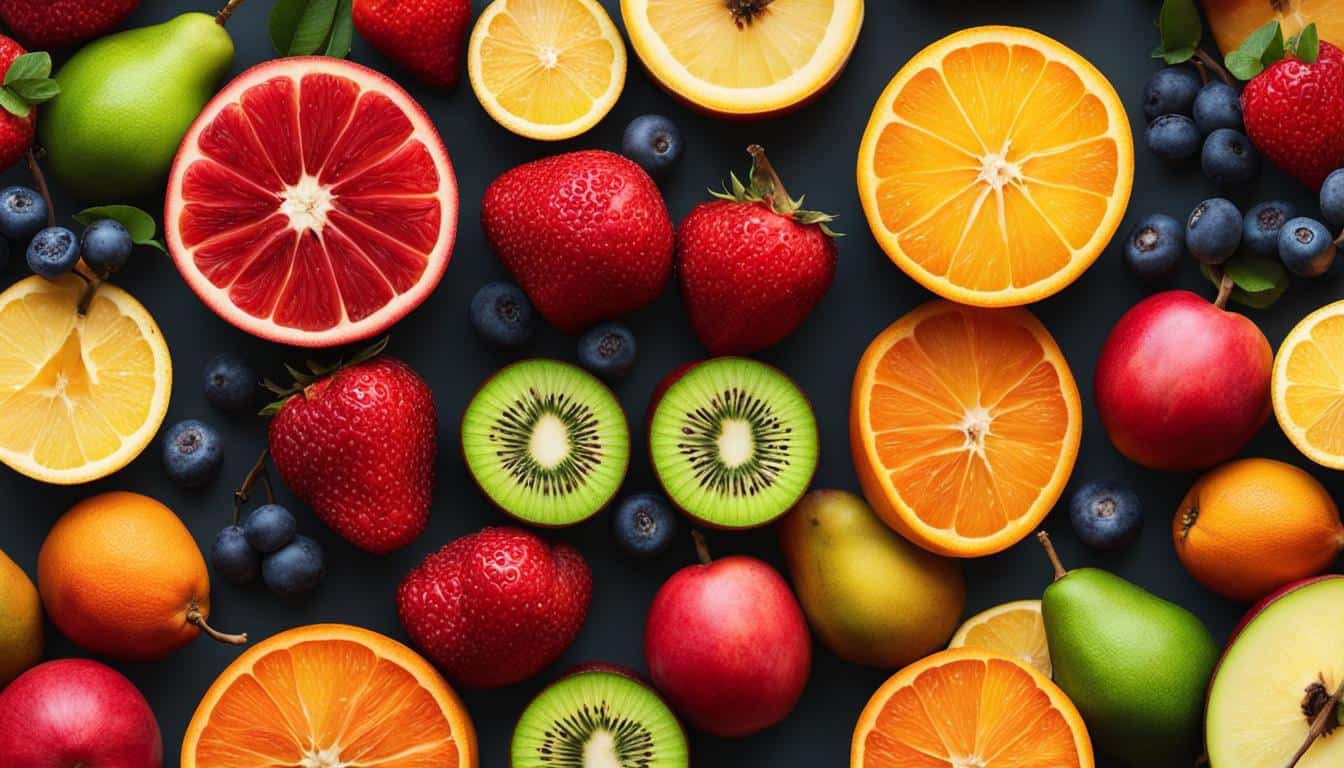



Leave a Reply